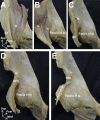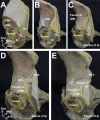An Anatomical Study of the Anterosuperior Capsular Attachment Site on the Acetabulum
- PMID: 31483398
- PMCID: PMC7406147
- DOI: 10.2106/JBJS.19.00034
An Anatomical Study of the Anterosuperior Capsular Attachment Site on the Acetabulum
Abstract
Background: Despite the fact that many surgeons perform partial capsular detachment from the anterosuperior aspect of the acetabulum to correct acetabular deformities during hip arthroscopy, few studies have focused on whether these detachments influence hip joint stability. The aim of this study was to investigate the capsular attachment on the anterosuperior aspect of the acetabulum. We hypothesized that the attachment on the inferior aspect of the anterior inferior iliac spine (AIIS) is wide and fibrocartilaginous and might have a substantial role in hip joint stability.
Methods: Fifteen hips from 9 cadavers of Japanese donors were analyzed. Eleven hips were analyzed macroscopically, and the other 4 were analyzed histologically. In all specimens, the 3-dimensional morphology of the acetabulum and AIIS was examined using micro-computed tomography (micro-CT).
Results: Macroscopic analysis showed that the widths of the capsular attachments varied according to the location, and the attachment width on the inferior edge of the AIIS was significantly larger than that on the anterosuperior aspect of the acetabulum. Moreover, the capsular attachment on the inferior edge of the AIIS corresponded with the impression, which was identified by micro-CT. Histological analysis revealed that the hip joint capsule on the inferior edge of the AIIS attached to the acetabulum adjacent to the proximal margin of the labrum. In addition, the hip joint capsule attached to the inferior edge of the AIIS via the fibrocartilage.
Conclusions: The capsular attachment on the inferior edge of the AIIS was characterized by an osseous impression, large attachment width, and distributed fibrocartilage.
Clinical relevance: It appeared that the capsular attachment on the inferior edge of the AIIS was highly adaptive to mechanical stress, on the basis of its osseous impression, attachment width, and histological features. Anatomical knowledge of the capsular attachment on the inferior edge of the AIIS provides a better understanding of the pathological condition of hip joint instability.
Figures






References
-
- Ganz R, Parvizi J, Beck M, Leunig M, Nötzli H, Siebenrock KA. Femoroacetabular impingement: a cause for osteoarthritis of the hip. Clin Orthop Relat Res. 2003. December;417:112-20. - PubMed
-
- Bedi A, Kelly BT. Femoroacetabular impingement. J Bone Joint Surg Am. 2013. January 2;95(1):82-92. - PubMed
-
- Griffin DR, Dickenson EJ, O’Donnell J, Agricola R, Awan T, Beck M, Clohisy JC, Dijkstra HP, Falvey E, Gimpel M, Hinman RS, Hölmich P, Kassarjian A, Martin HD, Martin R, Mather RC, Philippon MJ, Reiman MP, Takla A, Thorborg K, Walker S, Weir A, Bennell KL. The Warwick Agreement on femoroacetabular impingement syndrome (FAI syndrome): an international consensus statement. Br J Sports Med. 2016. October;50(19):1169-76. - PubMed
-
- Griffin DR, Dickenson EJ, Wall PDH, Achana F, Donovan JL, Griffin J, Hobson R, Hutchinson CE, Jepson M, Parsons NR, Petrou S, Realpe A, Smith J, Foster NE; FASHIoN Study Group. Hip arthroscopy versus best conservative care for the treatment of femoroacetabular impingement syndrome (UK FASHIoN): a multicentre randomised controlled trial. Lancet. 2018. June 2;391(10136):2225-35. Epub 2018 Jun 1. - PMC - PubMed
MeSH terms
LinkOut - more resources
Full Text Sources

